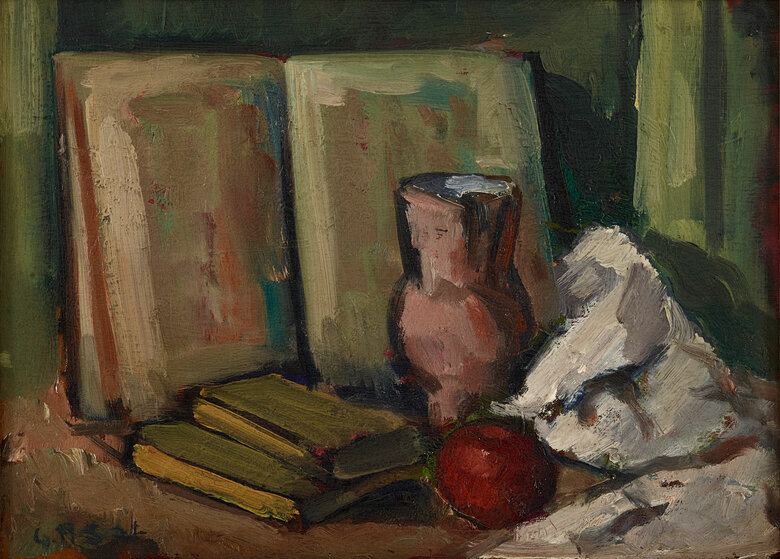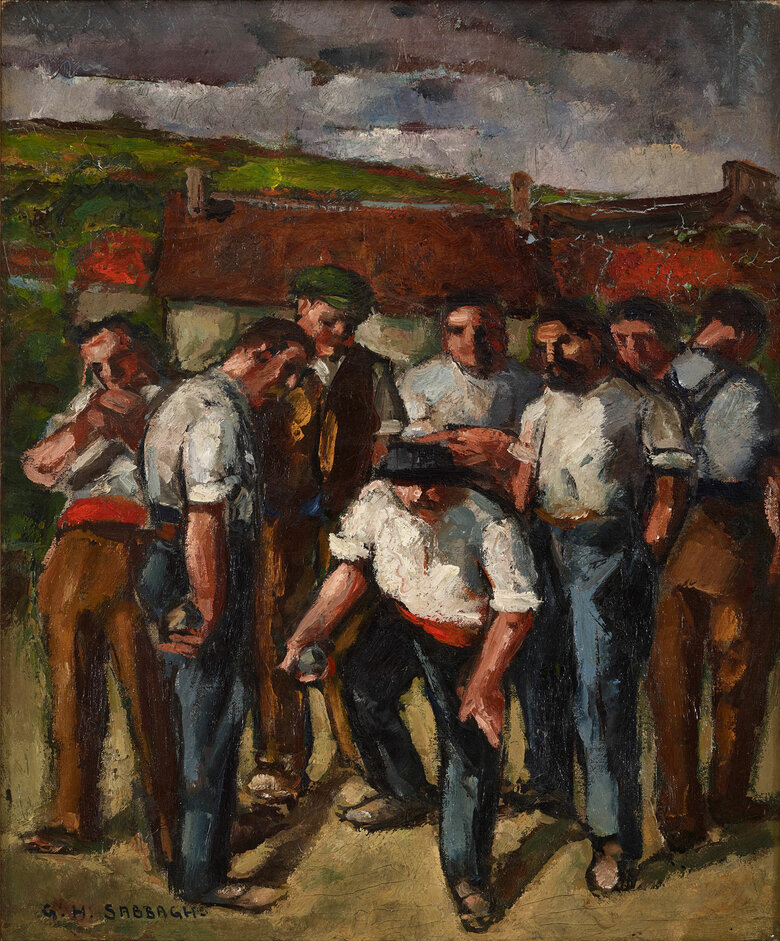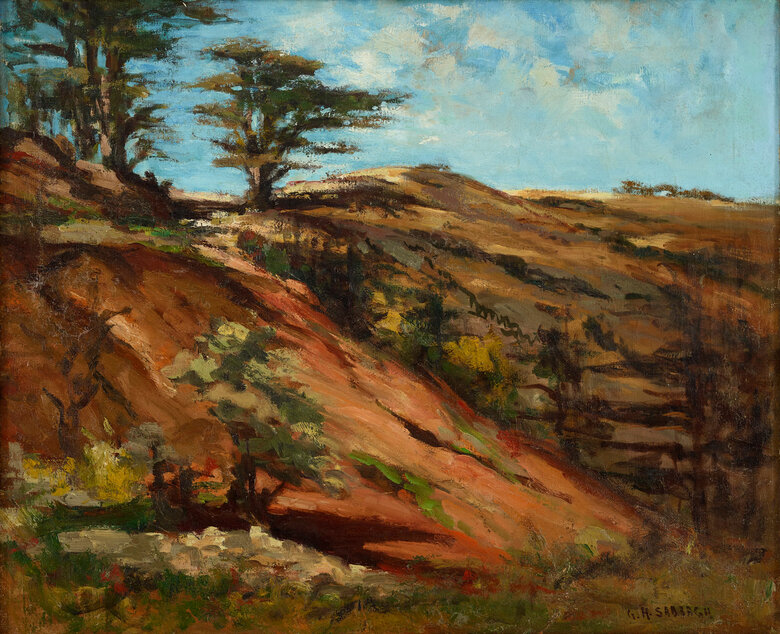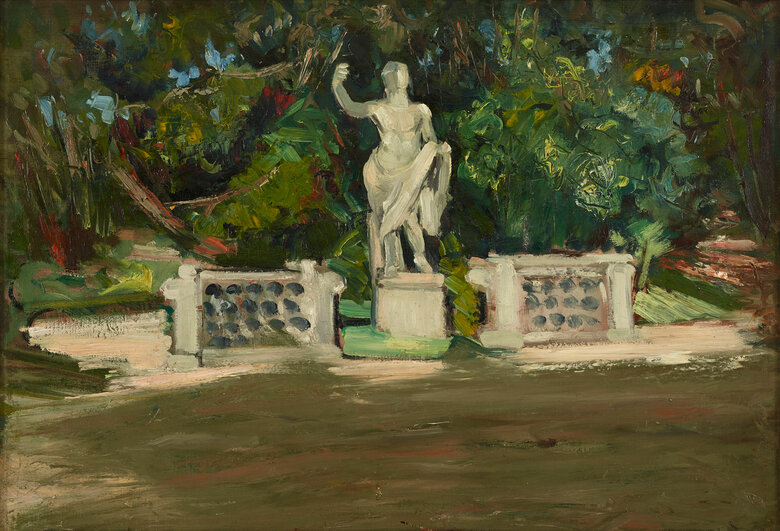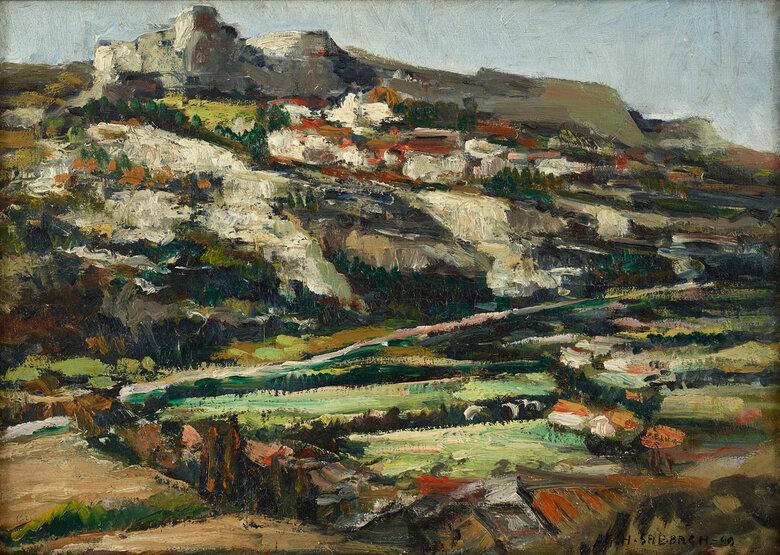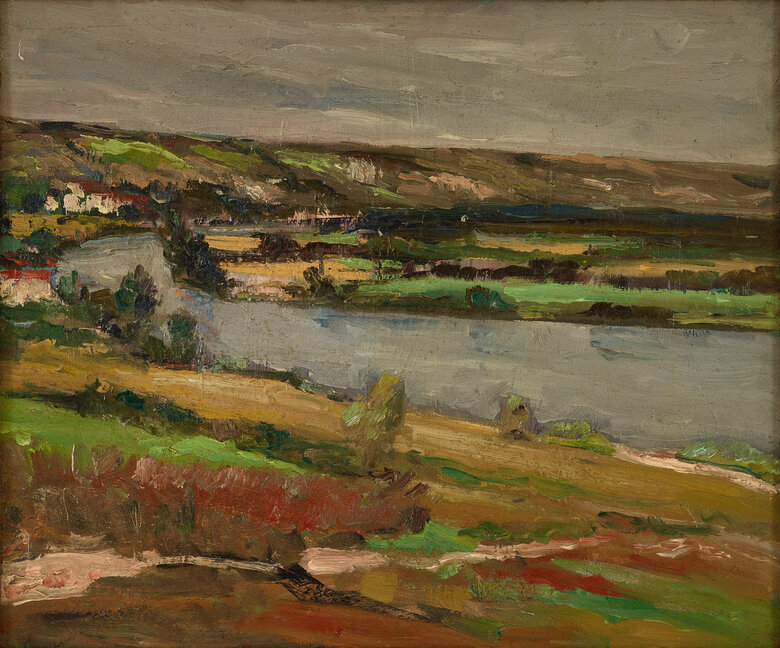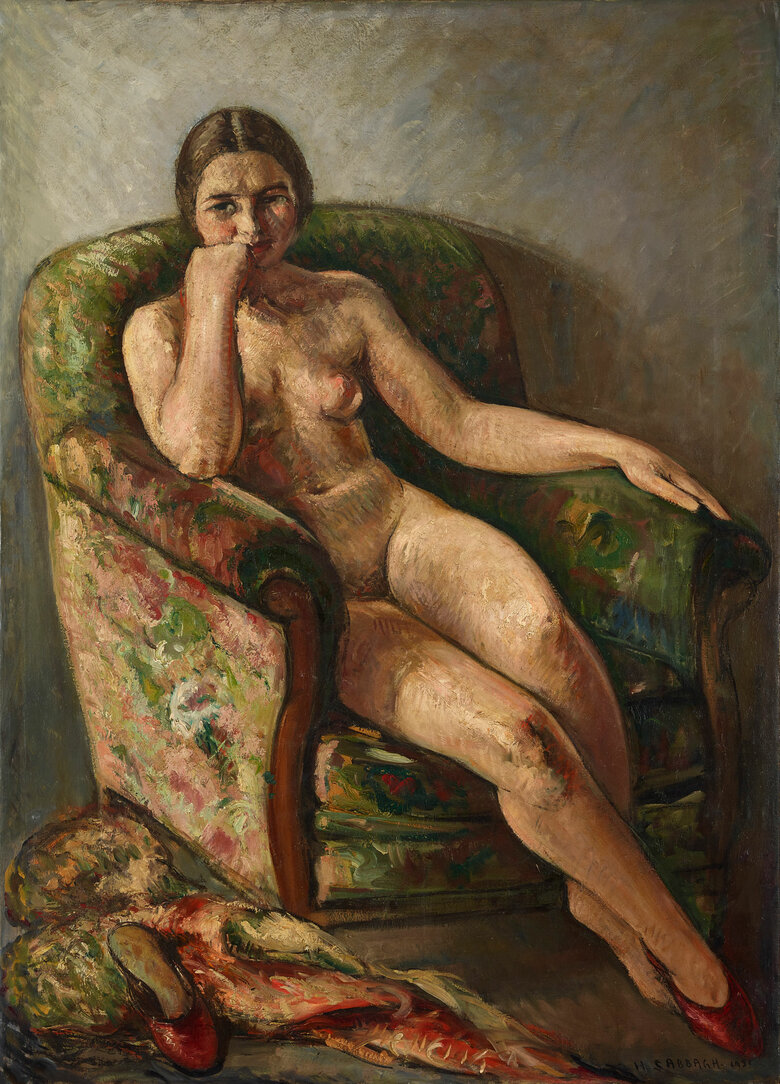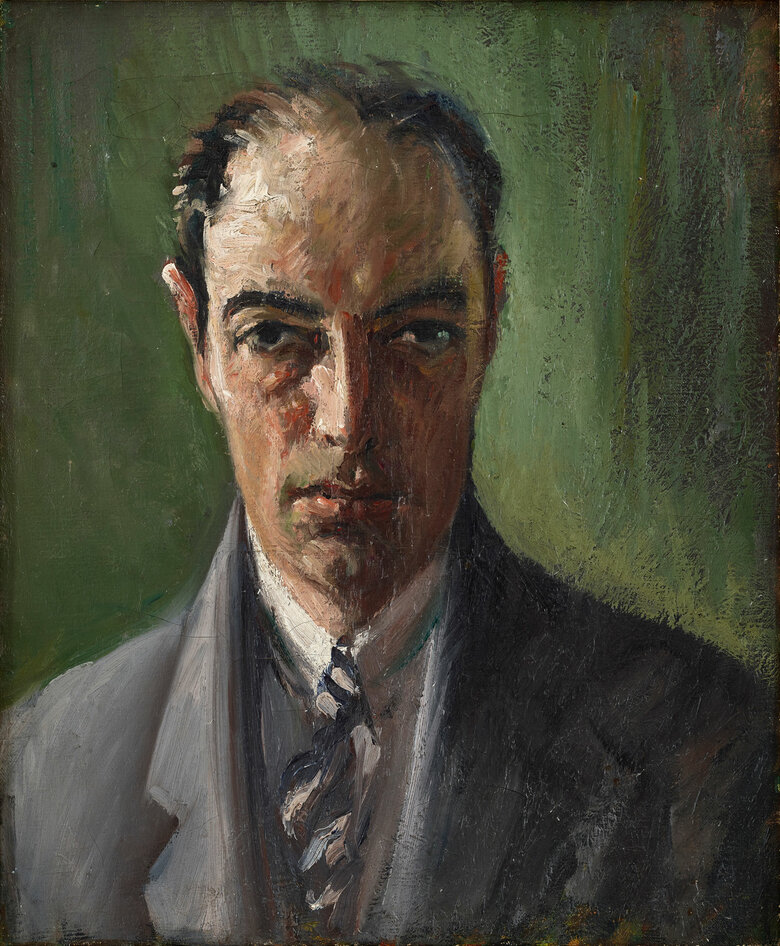Born in Alexandria in 1887, Georges Hanna Sabbagh grew up in a wealthy Copt family of Lebanese origins. Being part of the local elite, he received a quality French education at the École des...
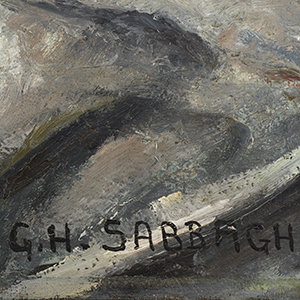

GEORGES HANNA SABBAGH, Egypt (1887 - 1951)
Bio
Written by ARTHUR DEBSI
Born in Alexandria in 1887, Georges Hanna Sabbagh grew up in a wealthy Copt family of Lebanese origins. Being part of the local elite, he received a quality French education at the École des Jésuites. He then traveled to France, where he started studying law in 1905. However, Sabbagh did not assiduously follow his studies, and preferred to frequent the intellectual, and artistic circles of the French capital city. Despite the fact that this choice of lifestyle was not approved by his father – who even stopped supporting him1 – Georges Sabbagh eventually abandoned his law studies. He started attending courses at the atelier of French artist Levy Dhurmer (1865-1953), before completing his training at the Académie Ranson, in 1910. This institution is famous for shaping the French painters Maurice Denis (1870-1943), Felix Vallotton (1865-1925), and Paul Sérusier (1864-1927), who had earlier founded the post-impressionist movement called ‘Nabi’, in 1888. Sabbagh was actually trained by these three artists, and progressively became active in the artistic dynamic in Paris. He frequented the vibrant district of Montparnasse, and participated in several major art events such as the annual Salon d’Automne, the Salon des Indépendants, and the Salon des Tuileries throughout his career in France.
After the outbreak of World War I, Georges Sabbagh traveled to England, where he was employed at the factory of Rolls Royce in the city of Derby, from 1914 to 1917. Being well-settled in France after fifteen years, he suddenly had to go to Egypt, where his mother passed away in 1920. From then on, he visited his home country regularly. However, in 1933, he traveled there on an official mission requested by the authorities, where he had to organize an exhibition about French artefacts belonging to the Egyptian State back then. That same year, he was appointed head of the department of painting at the Salon d’Automne in Paris.
During the 1930s, Sabbagh somehow gained more and more recognition in his home country. In 1934, he got divorced from his wife, and left France to relocate for a longer period in Cairo. There, he established himself in the district of Zamalek. He then actively contributed to the Egyptian artistic scene, for example through the organization of multiple exhibitions of French paintings in Cairo and Alexandria in the late 1930s. In 1939, he started giving painting courses at the École des Beaux-Arts in Cairo. After World War II, he moved back to France, and remained in Paris until his death.
One of the multiple nicknames which were accurately attributed to Georges Hanna Sabbagh is the ‘son of Egypt who became the adopted child of France’2. France was somehow the adopted country of the artist, who became a French citizen in 1930. He was even presented with the Légion d’Honneur. Furthermore, Sabbagh fully belonged to the avant-garde art movement from the early decades of the 20th century in Paris. The city was a cultural hearth, which attracted artists from all around Europe. Such artists included Italian painter Amedeo Modigliani (1884-1920), and Russian painter Chaïm Soutine (1893-1943). These would come to freely practice their arts, and constituted a group of artists called ‘École de Paris’. it was a gathering of painters, sculptors, photographers, poets, and musicians. Coming from Egypt, Georges Sabbagh remembered that he was nicknamed “le rameau de l’École de Paris”3.
In 1918, Georges Hanna Sabbagh executed the artwork called Les Joueurs de cartes (The Card players), which is actually his own version of the painting of the same name, by Paul Cézanne (1839-1906) dated from 1894-1895. However, paying tribute to the French master, Sabbagh portrayed him playing with Dutch painter Vincent van Gogh (1853-1980)4.
In France, Georges Sabbagh was considered to be “one of the heirs of the Nabis”5, as well as the “peintre de la Bretagne et de la mer”6. For the first time, he visited Brittany in 1916, where he spent the summer with his wife Agnès Humbert (1894-1963), and his teacher and friend, Maurice Denis (1870-1943). Since that summer, the artist began to frequent there, and even constructed a house in Ploumanac’h. Like the Nabi painters, Sabbagh built a peculiar connection with this region in Western France, where he could find spirituality in the landscapes. As a matter of fact, the Egyptian painter was captivated by the grandeur of nature, including the sea, the rocks, and the rich vegetation. He learned how to study this nature from Maurice Denis (1870-1943)7. In the process of painting, Sabbagh truly took time to observe the environment, that could be related to a meditative moment, as he said “For hours, I watched the rhythm of the waves, the movement that reflects itself and that makes one irresistibly think of the movements of an animal”8. This is seen in the example Rock of Mulet in Ploumanac’h (1933), part of the Dalloul Art Foundation’s collection, where Sabbagh depicted a typical view over the maritime landscape of Brittany. Applying a palette of cool colors, he meticulously illustrated a grey sky, and suggested the wind through the moves of the waves, which break on the rocks. The large dimensions of the painting perfectly render the vast landscape expanse, and also reveal the relationship between the artist and the nature. Indeed, Sabbagh’s fascination for nature, also involved a feeling of littleness, and submission: “(…) Je pense avoir fait un grand pas dans le sens de l’humilité et la soumission à la nature, grande, belle, tyrannique, séduisante et énigmatique maîtresse"9. In Rock of Mulet in Ploumanac’h (1933), the rocks are massive, and embody the power of nature. Empty of human presence, this coastal scenery is almost threatening, and conveys some tension between calmness, and agitation, serenity, and angst.
In one of his articles, Paris-based journalist Robert Vaucher (1890-1977) called Georges Sabbagh the “peintre du nu”10. His oeuvre effectively encompasses an important production of nudes, which correspond to a time when the Egyptian artist sought for a form of stability in his work. After World War I, a brief art trend, defined as a ‘return to order’, took place in Europe in response to the atrocities and traumas caused by the conflict. The artists somehow detached themselves from avant-garde movements like Cubism, and dug into traditional art to find their inspirations. In the 1920s, Sabbagh consequently executed nude paintings like Le Nu au peignoir blanc (1926), part of a large series of nudes from the Dalloul Art Foundation’s collection, referring to classical themes, and more precisely mythology. Here, he produced a full-length portrait of a naked lady, who is standing on the beach, and is holding a white thick bathrobe. The position of the character, as well as the fact that she is coming out of the sea, recalls one of the traditional representations of the ‘Venus Anadyomene’ from Greek and Roman Antiquity imagery. This representation shows the goddess Venus, also coming out of the sea, where she was born, and arriving on earth. Although Georges Sabbagh alluded to the myth, he reinterpreted it through a modern and personal style. Freeing himself from the idealization of the female body, he tended to illustrate “modest beauty”11, as Ahmed Bey Rassim (1895-1958) wrote. In Le Nu au peignoir blanc (1926), the lady shamelessly unveils her body, which is imposing, and colossal, compared to the small-sized swimmers in the background. Highly tinged with sensuality, the artist decided to depict a ‘real’ woman, normalizing her body by drawing her pubic hair and some imperfections – judging from some standards of beauty. He also modernized her look by giving her an ‘à la garçonne’ haircut, which was very popular in the post-war time. Thus, this art piece demonstrates how Sabbagh had a strong classical culture that he was able to surpass in order to create a modern nude.
The complexity to determine Georges Sabbagh’s cultural affiliation mainly relies on the fact that he always lived in the cosmopolite society of Alexandria, where Muslims, Christians, Europeans, Arabs, and locals coexisted. Regardless of his strict French education, it is worth asserting that the painter stayed true to his Egyptian roots and values throughout his life. When he returned to Egypt in 1920, Sabbagh only stayed a couple of months. Yet, he traveled all over the country, rediscovering the landscapes of his childhood with a particular fascination for the Nile. Nevertheless, the artist never adopted an orientalist artistic point of view to paint what he experienced. On the contrary, his vision of Egypt is more symbolic rather than pure fantasy as he wrote to the French art critic René-Jean (1879-1951): "Ici en Égypte, le soleil est beau, les teintes superbes, la lumière transparente et les femmes sculpturales; les hommes superbes ne se doutent pas de la beauté de la race qui émane d’eux. Les parfums sont délicieux, ils nous entourent et se prolongent toute la journée et au-delà… Alors on trouve que la vie vaut d’être vécue…”12. The painting Nu allongé (1921), also part of the Dalloul Art Foundation’s collection, reveals the impressions of the artist and his feelings towards Egypt. The artist produced another nude, which differs from the usual ones, especially in its plastic treatment, with an echo of Modigliani’s palette of warm colors from the 1900s. Sabbagh painted a naked person who could be a man or a woman, in a spectacular position, lying down on a bed, and resting their head on a red pillow. With a tendency for geometrical painting, the painter played on the triangular shape, present in different parts of the scene, such as the legs of the model. Here, he subtly interpreted his inspiration from Egypt, modelling the body of the character like a pyramidal construction, covered with a bright light. This scene could evoke the light of Egypt, which illuminates the Pharaonic edifices from Ancient times.
Georges Hanna Sabbagh said in reference to himself: “I am neither of Brittany, Paris, Nabi, nor cubist. I am a painter of the Orient and the West; a man from Africa, the Levant and Europe, a Mediterranean in love with light and life”13. It seems that he refused any categorizations, or strict cultural attachments. This hybrid personality led him to create with profound freedom, a painting, which combines tradition and modernity through a sensitive artistic approach.
Georges Hanna Sabbagh passed away in 1951, in Paris.
Notes
1 Kanafani, Fatenn Mostafa. Modern Art in Egypt: Identity and Independence, 1850-1936. London, United Kingdom: I.B. Tauris, Bloomsbury Publishing, 2020. [P.95]
2 Blum, Robert. ‘En causant avec le peintre G.H.Sabbagh’, Images, no.176, January 28, 1993 in Kanafani, Fatenn Mostafa. Modern Art in Egypt: Identity and Independence, 1850-1936. London, United Kingdom: I.B. Tauris, Bloomsbury Publishing, 2020. [P.116]
3 ‘The Palm of the École de Paris’. Sabbagh, Georges. ‘Georges Sabbagh vu par lui-même’, in Confidences du peintre G.H.Sabbagh sur sa peinture et sur la peinture, Premier Cahier (1920-1925), [P.5]. Quote in Kanafani, Fatenn Mostafa. Op.cit., 2020. [P.98]
4 Sabbagh, Jean, Monique Sabbagh, Mathilde Sabbagh, and Marc Sabbagh. Georges Sabbagh. Paris, France: Panama Musées, 2006. [P.20]
5 Sabbagh, Georges. ‘Georges Sabbagh vu par lui-même’ in Sabbagh, Georges. Op.cit, 1991. Quote in Kanafani, Fatenn Mostafa. Op.cit., 2020. [P.116]
6 ‘Painter of Brittany and the sea’. Sabbagh, Jean, Monique Sabbagh, Mathilde Sabbagh, and Marc Sabbagh. Georges Sabbagh. Paris, France: Panama Musées, 2006. [P.100]
7 Bréon, Emmanuel. ‘Sabbagh le Breton’ in Bréon, Emmanuel, Michèle Lefrançois, Bernard Dorival, and Jean Sabbagh. Georges Sabbagh: Alexandrie 1887-Paris 1951. [Cat. Exh. ‘Georges Sabbagh: Alexandrie 1887-Paris 1951’. Boulogne (France), Musée Municipal de Boulogne, 1990], Thonon-les-Bains, France: L'Albaron, 1990. [P.63]
8 René-Jean, ‘L’exposition G.-H.Sabbagh exalte la montagne’, Comoedia, 3 December 1931, p.3. Quote in Kanafani, Fatenn Mostafa. Op. cit., 2020. [P.108]
9 ‘I think I have made a big step when it comes to humility and submission to nature – large, beautiful, tyrannical, seducing and enigmatic mistress’. Dorival, Bernard. ‘Georges Sabbagh et son temps’ in Bréon, Emmanuel, Michèle Lefrançois, Bernard Dorival, and Jean Sabbagh. Op.cit., 1990. [P.28]
10 ‘Painter of the nude’. Vaucher, Robert. ‘Un grand peintre Égyptien’, Correspondance d’Orient, no.334, October 1925. Quote in Kanafani, Fatenn Mostafa. Op.cit., 2020. [P.116]
11 Rassim, Ahmed Bey. Sabbagh, peintre d’Orient. Cairo, Egypt, 1936. Quote in Kanafani, Fatenn Mostafa. Op.cit., 2020. [P.104]
12 ‘In Egypt, the sun is beautiful, the colors are superb, the light is transparent and the women are sculptural. The beautiful men are not aware of the beauty, which emanates from themselves. The perfumes are exquisite. They surround us and continue till the end of the day, then we realize that life is worth living’. Correspondence with René-Jean, 1922-1946 retrieved in Lefrançois, Michèle. ‘Sabbagh, L’Égyptien’ in Bréon, Emmanuel, Michèle Lefrançois, Bernard Dorival, and Jean Sabbagh. Op.cit., 1990. [P.70]
13 ‘Georges Sabbagh vu par lui-même’, in Confidences du peintre G.H.Sabbagh sur sa peinture et sur la peinture, Premier Cahier (1920-1925), [P.5]. Quote in Kanafani, Fatenn Mostafa. Op.cit., 2020. [P.117]
Sources
Abaza, Mona, and Sherwet Shafei. Twentieth-Century Egyptian Art: the Private Collection of Sherwet Shafei. Cairo, Egypt: American University in Cairo Press, 2011.
Azar Aimé. La Peinture Moderne En Egypte. Caire, Egypt: Editions Nouvelles, 1961.
Bréon, Emmanuel, Michèle Lefrançois, Bernard Dorival, and Jean Sabbagh. Georges Sabbagh: Alexandrie 1887-Paris 1951. [Cat. Exh. ‘Georges Sabbagh: Alexandrie 1887-Paris 1951’. Boulogne (France), Musée Municipal de Boulogne, 1990], Thonon-les-Bains, France: L'Albaron, 1990.
Bardaouil, Sam. “Ni Ici, Ni Là-Bas : Mahmoud Mokhtar Et Georges Sabbagh.” Qantara, no. 87, Dossier : L’Égypte en son miroir : arts et littératures XIXème siècle – XXIème siècle, (2013).
Eigner, Saeb. Art of the Middle-East, Modern and Contemporary Art of the Arab World and Iran. London, UK: Merell Publishers Limited, 2011.
Esanu, Octavian. Art, Awakening, and Modernity in the Middle East: the Arab Nude. Oxon, United Kingdom: Routledge, 2018.
Kanafani, Fatenn Mostafa. Modern Art in Egypt: Identity and Independence, 1850-1936. London, United Kingdom: I.B. Tauris, Bloomsbury Publishing, 2020.
Karnouk, Liliane. Modern Egyptian Art, 1920-2003. Cairo, New York, Egypt, USA: The American University in Cairo Press, 2005.
Naef, Silvia. A La Recherche D'une modernité Arabe L'évolution Des Arts Plastiques En Egypte, Au Liban Et En Irak. Genève, Switzerland: Slatkine Reprints, 1996.
Sabbagh, Jean, Monique Sabbagh, Mathilde Sabbagh, and Marc Sabbagh. Georges Sabbagh. Paris, France: Panama Musées, 2006.
CV
Selected Solo Exhibitions
1993
Hommage à Georges Sabbagh, Société nationale des beaux-arts, Paris, France
1990
Georges Sabbagh : Alexandrie, 1887-Paris, 1951, Municipal Museum of Boulogne-Billancourt, France
1988
Georges Sabbagh et ses amis peintres de la Bretagne, Perros-Guirec, Exposition monographique, Crozant, France
1987
Hommage à Sabbagh,Salon d’automne,Grand Palais, Paris, France
1986
Hommage à Sabbagh,mairie du 6earrondissement, Paris, France
1982
Monographic exhibition, Centre culturel égyptien, Paris, France
1955
Monographic exhibition, galerie Allard, Paris, France
1952
Retrospective exhibition, Salon d’Automne, Grand Palais, Paris, France
1951
Galerie Motte, Genève, Switzerland
Lausanne, Switzerland
Paris, France
1949
Exhibited in Paris, France
1948
Exhibited in Paris, France
1947
Exhibited in Cairo, Egypt
1946
Exhibited in Paris , France
1938
Exhibited in Paris, France
1937
Exhibited in Paris, France
1936
Exhibited in Paris, France
1934
Galerie Ramia, Alexandrie, Egypt
1929
Galerie Charpentier, Paris, France
1921
Galerie Druet, Paris, France
Galerie Berthe Weill, Paris, France
Tuileries, Paris , France
1917
Galerie Chéron, Paris, France
Selected Group Exhibitions
2024
Arab Presences: Modern Art And Decolonisation: Paris 1908-1988, Musée d'Art Moderne de Paris, Paris, France
The Collector´s Eye XI, Ubuntu Art Gallery, Cairo, Egypt
2023
Partisans of the Nude: An Arab Art Genre in an Era of Contest, 1920-1960, Wallach Art Gallery, Columbia University, Harlem, New York, USA
Je Suis Inculte! The Salon d’Automne and the National Canon, Sursock Museum, Beirut, Lebanon
2022
The Egyptian Art in the Twenties of the Last Century, Centre des Arts, Aisha Fahmy Palace, Cairo, Egypt
2019
From Mokhtar to Gazbia, Art Talks, Cairo, Egypt
2013
Le Théorème de Nefertiti, Institut du Monde Arabe, Paris, France
Tea with Nefertiti: The Making of the Artwork, the Museum and the Public, Mathaf: Arab Museum of Modern Art, Doha – Qatar
2012
Le Corps découvert, Institut du Monde Arabe, Paris, France
2001
Regards de peintres autour de Ploumanac’h, musée de Saint-Brieuc (mai-juin) ; Perros-Guirec, maison de Traouïero (juillet-septembre)
1961
Group Exhibition, museum, Saint-Denis – France
1945
Salon d’automne, Paris- France
1931
Salon d’automne, Paris- France
1923
Salon des Indépendants, Paris, France
1922
Salon des Indépendants, Paris, France
Salon d'Automne, Paris, France
1920
Salon des Indépendants, Paris, France
Salon d'Automne, Paris, France
Awards and Honors
1944
General Commissioner of the French exhibition which brings together, in Algiers, the works of the museums of Cairo, Alexandria, Beirut and Jerusalem.
1936
Organized a contemporary French painting exhibition in Alexandria.
1933
Named President of the painting section of the Salon d’Automne society.
1930
Named Knight of the Legion of Honor in France.
Curatorial Projects
1936
Organizes an exhibition in Egypt for contemporary French artists.
1933
Missioned by the Egyptian State to organize an exhibition of treasures of French art owned by Egypt.
Collections
Crozant Crozant City Hall, France
André-Malraux Modern Art Museum, Le Havre, France
Paris Modern Art Museum, Paris, France
Contemporary History Museum, Hotel National des Invalides, Paris, France
La Princerie Museum, Verdun, France
Painting and Sculpture Museum of Grenoble, Grenoble, France
Tourcoing Museum, Tourcoing, France
Departmental Museum of L’Oise, Beauvais, France
Departmental Museum of Prieuré, France
Maurice-Denis Departmental Museum “Le Prieuré”, Saint-Germain-en-Laye, France
The 1930s Museum, Boulogne-Billancourt, France
National Modern Art Museum, Centre Georges Pompidou, Paris, France
Rio de Janeiro Museum, Rio, Brazil
Mohammed Mahmoud Khalil Museum, Cairo, Egypt
National Modern Art Museum, Cairo, Egypt
Nederlands Letterkundig Museum, La Haye, Netherlands
Ramzi and Saeda Daloul Art Foundation, Beirut, Lebanon
Mathaf: Arab Museum of Modern Art in Doha, Qatar
Press
Le corps découvert dans l_art arabe _ exposition prolongée.pdf
طباعة الاخبار-بيع لوحة الرسام الشهير جورج الصباغ بـ110,000 دولار فى كريستى.pdf
Georges_Sabbagh_and_the_development_of_t.pdf
چورچ الصباغ.. أيقونة الفن التشكيلى.pdf
GeorgesHannahSbbagh_Le corps découvert dans l_art arabe - Exposition prolongée_Press.pdf
wrmea.org-Art Exhibitions Engage in Palestinian Existential Contest.pdf
qantara-ni-ici-ni-la-bas-mahmoud-moukhtar-and-georges-sabbagh.pdf
طباعة الاخبار-بيع لوحة الرسام الشهير جورج الصباغ بـ110,000 دولار فى كريستى.pdf
Georges Hanna Sabbagh – Mythology.pdf
GEORGES HANNA SABBAGH Artwork
Become a Member
Join us in our endless discovery of modern and contemporary Arab art
Become a Member
Get updates from DAF
Follow Artists
Save your favourite Artworks
Share your perspectives on Artworks
Be part of our community
It's Free!
We value your privacy
TermsCookiesPrivacy Policies
Become a Member
Get updates from DAF
Follow Artists
Save your favourite Artworks
Share your perspectives on Artworks
Be part of our community
It's Free!
We value your privacy
TermsCookiesPrivacy Policies
Become a Member
Get updates from DAF
Follow Artists
Save your favourite Artworks
Share your perspectives on Artworks
Be part of our community
It's Free!
We value your privacy
TermsCookiesPrivacy Policies
Welcome to the Dalloul Art Foundation
Thank you for joining our community
If you have entered your email to become a member of the Dalloul Art Foundation, please click the button below to confirm your email and agree to our Terms, Cookie & Privacy policies.
We value your privacy, see how
Become a Member
Get updates from DAF
Follow Artists
Save your favourite Artworks
Share your perspectives on Artworks
Be part of our community
It's Free!
We value your privacy
TermsCookiesPrivacy Policies

